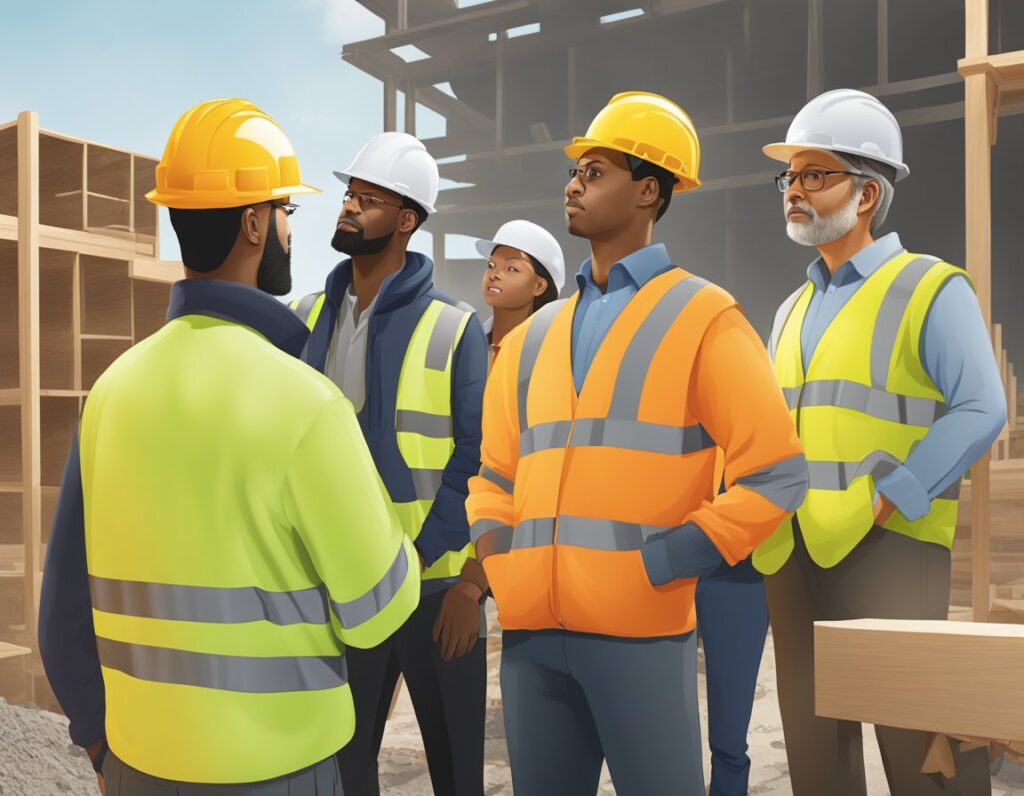Safety training is an integral component of any construction project, ensuring that all team members are well-informed about potential hazards and know how to avoid them.
In the UK, construction sites are bound by stringent safety regulations, but for charity-based projects, these guidelines are just as critical.
Often operated with limited funds and by volunteers who might not have extensive construction experience, these projects require tailored safety training that acknowledges their unique context.

Charitable organisations venturing into construction, whether for new builds or renovation work, have to ensure that their volunteers and employees are equipped with the knowledge to maintain a safe working environment.
The complexity of safety training can vary from basic awareness to comprehensive programmes like the Site Management Safety Training Scheme (SMSTS), which is designed for managerial roles but could be highly beneficial for charity project leaders.
Similarly, safety courses can be specifically adapted to meet the needs of non-profit projects, ensuring that the standards of safety are never compromised, regardless of the project’s charitable status.
Key Takeaways
- Construction site safety training is vital for all UK projects, including charitable ones.
- Tailored safety programmes are necessary for the diverse experience levels of charity project teams.
- Specialist schemes and courses can enhance safety leadership within charitable construction efforts.
Fundamentals of Construction Site Safety
Building a robust framework for safety is vital to protecting workers on construction sites, especially in charity-based projects where resources can be limited.
By understanding and implementing the core aspects of site safety, you mitigate risks and create a secure working environment for all involved.
Regulatory Framework and Standards
In the UK, construction site safety is fundamentally governed by the Health and Safety at Work etc. Act 1974 and the Construction (Design and Management) Regulations 2015 (CDM 2015).
These legal frameworks require you to ensure that construction work is planned, managed, and monitored to safeguard the health and safety of all workers.
It’s your duty to comply with these regulations, which set the benchmarks for safety practices and the roles and responsibilities of everyone involved.
Risk Assessment and Management
Conducting thorough risk assessments is a cornerstone of managing safety on your site.
Identify potential hazards, evaluate the risks associated with them, and put appropriate measures in place to control or eliminate them.
It’s crucial to conduct these assessments before work commences and to review them regularly as work progresses or when there are significant changes.
Personal Protective Equipment
Personal Protective Equipment (PPE) is essential in providing a last line of defence against on-site risks.
Ensure that all personnel are outfitted with helmets, safety footwear, high-visibility clothing, and any other necessary PPE.
It’s also important that this equipment is well-maintained and that staff are trained in its correct use.
Common Hazards and Control Measures
Be aware of common hazards such as falls from height, moving machinery, electrical safety, noise, and manual handling.
Implementing control measures, like secure scaffolding, machinery guards, and clear signage, helps prevent accidents.
Ensure regular safety briefings and training are held to keep these control measures at the forefront of your team’s mind.
Developing Safety Training for Charitable Projects
Safety training is paramount in ensuring that charitable construction projects in the UK uphold high standards of health and safety.
It is essential for you to understand the specific requirements of safety training within this context.
Identifying Training Needs
Your first step is to assess the specific health and safety risks associated with the charitable construction project.
This should include a risk analysis of the construction site and an understanding of the types of activities that volunteers and workers will be performing.
For instance, if the project involves working at heights, training should cover the use of safety harnesses and fall arrest systems.
Engaging Volunteers and Beneficiaries
It’s crucial to consider that volunteers may not have prior construction experience.
Your training must therefore be comprehensible and accessible, ensuring that all volunteers understand how to operate safely.
Incorporate practical demonstrations into your training sessions, and ensure that beneficiaries, who may be interacting with the site, are aware of safety zones and procedures to prevent accidents.
Monitoring, Evaluation, and Continuous Improvement
Establish a system to monitor the effectiveness of your safety training. Use feedback forms and incident reports to gather data.
By evaluating this information, you can identify areas for improvement and update your training accordingly.
Remember, the goal is to continually enhance the safety standards of your charitable construction projects.
